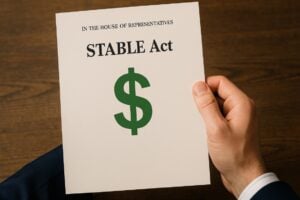The regulation of stablecoins in the United States takes an important step forward. The House Financial Services Committee has approved the bill known as the Stablecoin Transparency and Accountability for a Better Ledger Economy Act, abbreviated as the STABLE Act. With 32 votes in favor and 17 against, the text has been promoted in committee and is set to continue its legislative process, according to what has been reported by Bloomberg.
STABLE Act: a clear regulatory framework for a growing technology
Signed by the president of the Committee, the Republican representative French Hill (Arkansas), and his colleague Bryan Steil (Wisconsin), the bill aims to establish a comprehensive regulatory framework for the issuance and supervision of dollar-pegged stablecoins. The STABLE Act seeks to provide transparency, regulatory tools, and safeguards that allow the United States to lead financial innovation without sacrificing security and legality.
“Blockchain technology continues to transform the way money moves, and regulators must keep up with these transformations,” observed Hill during the hearing.
Strict requirements for reserves and anti-money laundering for stablecoin issuers
One of the fundamental pillars of the STABLE Act is the introduction of stringent standards regarding reserve coverage. Stablecoins, to comply with the regulation, must have one-to-one coverage, meaning reserves capable of guaranteeing the full value of the tokens issued on the market. Also foreseen are capital requirements and effective measures against anti-money laundering.
These mechanisms are designed to avoid systemic risks and to prevent abuses within a sector that is rapidly expanding and attracting both large investors and more speculative projects.
From the political impasse to a renewed momentum
It is not the first time that the Committee attempts to legislate on stablecoin. Already in 2023, a similar initiative had made some progress, but it then stalled due to disagreements between the parties and criticisms of the Biden administration, accused of hindering the negotiations.
The current version of the STABLE Act therefore represents a new bipartisan push to provide the country with clear regulation in the field of guaranteed digital currencies.
However, during the hearing, there were no shortages of divergences. Particularly heated were the discussions on how to manage the operations of foreign stablecoin issuers, such as Tether, and on the growing involvement of President Donald Trump in the cryptocurrency sector.
Fears for an increasingly politicized industry
The Democratic Representative Maxine Waters (California), a prominent figure of the party within the Committee, has expressed strong opposition to the STABLE Act. According to Waters, the law would open the door to abuses by political figures who might have personal interests in thecrypto ecosystem.
“This law creates a dangerous precedent. It ends up legitimizing attempts by entities within the system to write financial rules to their own advantage.”,
stated Waters during the speech.
His words make direct reference to recent revelations about the involvement of Trump and his family in the world of DeFi, Bitcoin mining, and tradable meme coin. An active participation that raises doubts about possible conflicts of interest in policy design.
Differences between Camera and Senato: two visions compared
Despite the approval of the STABLE Act by the House Committee, significant divergences remain with the parallel bill in the Senate, known as the GENIUS Act.
While the STABLE Act grants foreign issuers a two-year transition period to comply with U.S. regulations, the Senate measure takes a stricter approach, preventing new foreign operators from accessing the American market and allowing only the circulation in secondary markets of tokens already issued.
These differences in vision could complicate future negotiations for a shared version between the two branches of Congress.
The role of the crypto industry: Circle’s support
Representatives from the industry have also sided with regulation. Dante Disparte, chief strategy officer of Circle, praised the regulatory framework of the STABLE Act, calling it essential for consolidating the position of the United States in the new global digital economy.
Not by chance, Circle, issuer of USDC, one of the most used stablecoins, had just filed the documents for a stock market listing (IPO) the day before the vote in the Commission. A move that signals how crucial it is for companies in the sector to operate within a certain and recognized regulatory framework.
STABLE Act: towards a broader regulation of the market
In the coming days, the House Financial Services Committee will meet again to discuss a broader bill on market structure, which could integrate with what is provided in the STABLE Act. Representative Steil compared the two proposals to “peanut butter and jelly,” emphasizing how only together they can provide a complete picture.
The Federal Reserve has also made its voice heard. Last month, the president Jerome Powell, during a Senate hearing, confirmed the support of the American central bank for the creation of a regulatory system for stablecoins, emphasizing the need to ensure the protection of consumers and savers.
A regulated future for digital money
The advancement of the STABLE Act marks a crucial moment for the future of criptovalute regolamentate. As the United States considers how to tackle this financial revolution, the stakes remain high: leading global innovation without sacrificing systemic security and transparency.
With the push from legislators, the involvement of the industry, and the growing attention of regulators, the path towards stablecoin regulation is becoming increasingly concrete. It remains to be seen whether the House and Senate will be able to find common ground to consolidate a new regulatory model that will mark the next chapter of American digital finance.







